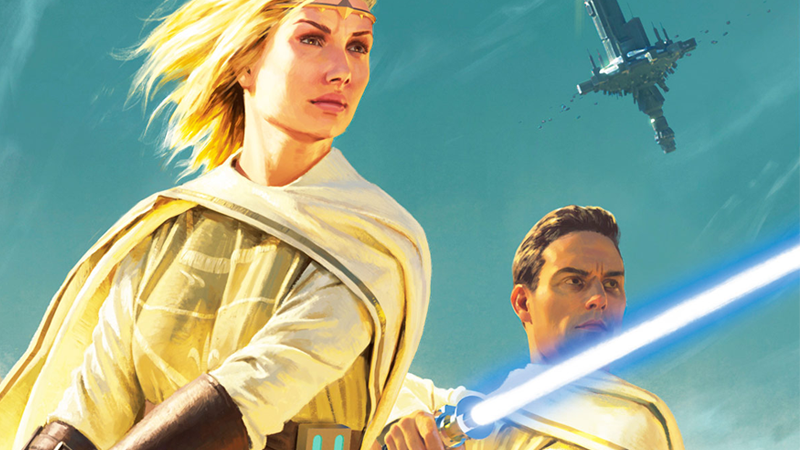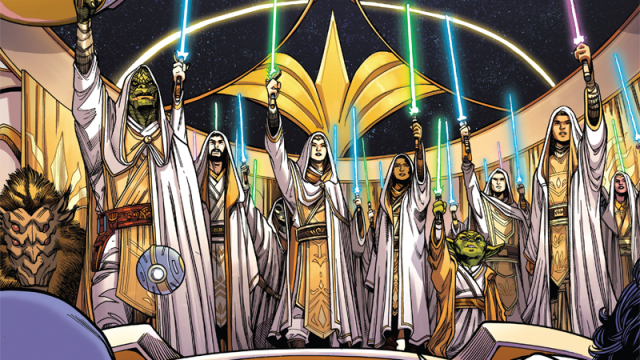“Attachment is forbidden. Possession is forbidden. Compassion, which I would define as unconditional love, is essential to a Jedi’s life. So you might say, that we are encouraged to love,” Anakin Skywalker tells Padmé Amidala in one of his many excruciatingly clumsy forays into foreplay in Star Wars: Episode II – Attack of the Clones. The need to keep their eventual romance a secret from the dogmatic forces of the Jedi Order ultimately lays an entire Republic low.
But as we meet that Republic at its high in Disney’s new Star Wars publishing initiative, and a Jedi Order at the apparent apex of its luminance, the time has come to perhaps reconsider that rule. Is attachment really such a bad thing to a Jedi Order that should feel more open and experimental, more considerate and compassionate, than it has ever before for it to truly feel at its apex?
[referenced id=”1664346″ url=”https://gizmodo.com.au/2021/01/breaking-down-star-wars-the-high-republic-old-jedi-new-tech-and-fascinating-connections/” thumb=”https://gizmodo.com.au/wp-content/uploads/2021/01/14/mgt4ocjtqci75qu0qli0-300×169.png” title=”Breaking Down Star Wars: The High Republic — Old Jedi, New Tech, and Fascinating Connections” excerpt=”The first wave of Star Wars: The High Republic stories is upon us, painting the broad strokes of what we can expect to see in this era, centuries before the Skywalker saga. After checking in with the new books and comics that hit shelves last week, we’re already getting a…”]
The concept of attachment comes up several times throughout the High Republic stories we’ve had so far, including this week’s release of Claudia Grey’s Into the Dark novel. It’s touched on in ways explicit and implicit — there are Jedi across these stories that, for example, question their bonds to their masters as their relationships evolve from Master/Apprentice to colleagues, or touch upon the restrictiveness of Jedi doctrine on certain fundamentals. But then there are also the acknowledgments that directly touch upon the Order’s rules about attachment.
In Light of the Jedi, for one example, the Jedi at the Elphrona Outpost adopt a local charhound — named, rather uncreatively by the quartet, Ember — acknowledging that while the Jedi do indeed have rules about personal attachments, her presence as a companion and friend to those stationed at the far-flung planet is a welcome, even necessary boon. It’s also a relationship that ultimately leads to Ember saving one of her Jedi friends during a Nihil ambush. And that’s before we get to something even more explicit beyond that: Jedi that love, forging romantic relationships whether inside the Order or beyond.
In general, the concept of love between Jedi is not an unknown thing, seemingly. Early on in the novel a Republic worker comments on his colleague’s love of Jedi romance novels, a genre of chivalric love and unrequited desires that was, at least, common and popular enough for neither the Jedi nor their allies in the Republic to disavow this sort of fiction being sold. And it was more than just the image of romantic Jedi on the frontier of space in literature, there were at the least some real Jedi who engaged in romantic relationships. Two of the most prominent characters in Light are Elzar Mann and Avar Kriss — the latter a vaunted symbol of the Order’s power and peace, as close to a perfect image of the Jedi as you could get; the former a bold, inventive experimentalist admired and admonished in equal measure by his peers for his desire to explore esoteric uses of the Force.

For as different as they might initially seem, Avar and Elzar are presented as extremely close friends in the novel, having grown up as fellow younglings, Padawans, Knights, and eventually by the time of the book’s end, Masters of the Order. They go everywhere together, on missions or on downtime. They are compassionate for each other, clearly. Their connection together allows them, as Jedi, to do spectacular things with the Force multiple times in the novel, building on Avar’s own unique ability to connect her fellow Jedi through the Force in powerful acts of sensitivity. One of the last scenes in Light between the two confirms something that felt keenly obvious in looking at their relationship throughout: at one point, as younger Jedi, Avar and Elzar were romantically entwined, before choosing to amicably separate to focus on their studies as apprentices of the Force.
Two Jedi. Two Jedi who loved each other. Who still do. Who are not just good friends, but deeply intimate with each other in a way that goes beyond friendship. Two Jedi who are, by very much any definition of the word, still emotionally attached to each other. And yet, has the Order imploded? Have these heretics who dared to defy doctrine fallen to the Dark Side like a switch flipped? No. Everything’s fine. Everything’s more than fine, everything’s great. This is a Jedi Order, we are constantly reminded both textually within these tales and metatextually by the creatives behind it, which is at the bright point in thousands of years of history for them. They have never been so respected, never been so connected to the Force, never been so light.
All of this, if not outright addressing it, at the least paints a picture that the Jedi Order of the time is confident enough in itself and its members that the concept of love and attachment is not the self-destructive taboo it is by the time we reach the more conservative iteration of the Jedi seen in the Star Wars prequels. Do the same rules exist? Yes, there are similar teachings about attachment, 200 years apart, but the way they are enforced is entirely different. What was wielded like a cudgel by the Council of the prequels — the tinder to the spark that was Anakin’s embrace of the dark side, be it over his attachment to his mother or his attachment to Padmé — is presented in The High Republic as something that feels radically different.
It’s a reminder to the Jedi we meet in these stories that relationships are not the be-all and end-all of connection, but merely one aspect of many wholes that represent their relationship to the Force. Aspects that co-exist in all of them, are not secrets to be shamed and hidden — and if not necessarily celebrated (the implication is that Elzar and Avar’s romance was private, but their closeness since is open enough for multiple people to comment on it), at least appreciated. And beyond that, understood. These Jedi would not have gotten through the stresses they’ve faced in these stories so far without leaning on friendship, on connection, and the trust and strength those intensely close bonds between people provide in times of crisis.
It’s something I sincerely hope The High Republic continues to explore. Not necessarily to tie this looseness with the doctrines of the Order to their eventual, inevitable downfall though — these Jedi are fated to give way to the dogmatism of the Jedi we meet in The Phantom Menace, after all, a world where someone like Qui-Gon is ostracised and looked down upon for even dabbling in more esoteric Force teachings, let alone Anakin’s treatment at the hands of the Council. That would feel like a terrible backward step, and thankfully, what we’ve seen of The High Republic so far does not seem to hint at such a parallel being made. But it would be nice to see more beyond the hints and glances we’ve got.
I’m not saying we need a Jedi romance novel of our own, or for our Masters and Knights to get their horny on 24/7. But so much of what we’ve seen in The High Republic is about the idea of connection — whether it’s the Jedi to the people they protect, the Republic’s own mantra of “We Are All the Republic,” or even the symbiotic relationship between Marchion Ro and the Nihil — that seeing Jedi who can understand that romance and attachment is as vital to understanding their place within the Force as meditation or scripture.
It’s the one thing that would really make them stand in contrast to the Jedi we know from the movies, and truly feel more powerful and more at one with themselves and the Force than any mastery of the lightsaber or the ability to move rocks with their minds ever could.
